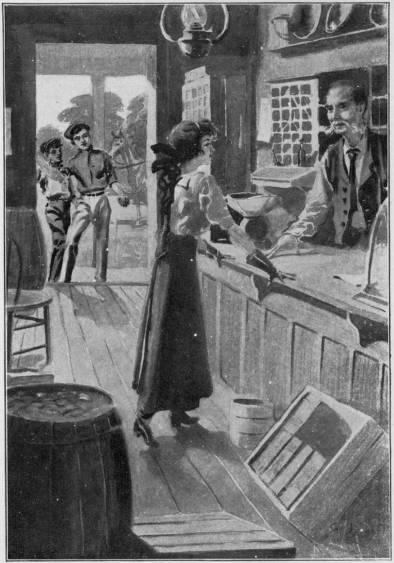
“Mr. Tedford, Have You Any Huyler Boxes?”
Dixie School Girl (Page 36)
A DIXIE SCHOOL
GIRL
BY
GABRIELLE E. JACKSON

MADE IN U.S.A.
M. A. DONOHUE & COMPANY
CHICAGO :: NEW YORK
COPYRIGHT 1913
BY
M. A. DONOHUE & COMPANY
Made in U. S. A.
TO MY TWO DIXIE NEIGHBORS,
whose entertaining tales of their childhood escapades have helpedto make these stories, this first volume of the “Dixie Girl” ismost affectionately inscribed by their friend.
G. E. J.
Four straight country roads running at rightangles. You cannot see where they begin becausethey have their beginning “over the hillsand far away,” but you can see where they endat “Four Corners,” the hub of that universe,for there stand the general store, which is alsothe postoffice, the “tavern,” as it is called inthat part of the world, the church, the rectory,and perhaps a dozen private dwellings.
“Four Corners” is oddly mis-named, becausethere are no corners there at all. It is acircle. Maybe it was originally four corners,but today it is certainly a circle with a big openspace in the center, and in the very middle ofthat stands a flag staff upon which floats thestars and stripes. The whole open space iscovered with the softest green turf. Not alawn, mind you, such as one may see in almost8any immaculately kept northern town, withartistic flower beds dotting it, and a carefullytrimmed border of foliage plants surrounding it.No, this circle has real Virginia turf; the thick,rich, indestructible turf one finds in England,which, as an old gardener told the writer, “werolls and tills it for a thousand years.” Naturehad been rolling and tilling this green plot ofground for a good many thousand years.
The circle was encompassed by an iron railfence to which the people from the surroundingcommunity hitched their saddle or carriagehorses when they came to the “Store” for theirmail, or to make various purchases. And therethe beasties often stood for hours, rubbing nosesand exchanging the gossip of the paddocks, horse(or mule) fashion.
There were always several hitched there, andthey were always gossiping or dozing as theywaited for their owners to start toward home,and they represented all sorts and conditionsof their kind just as those o